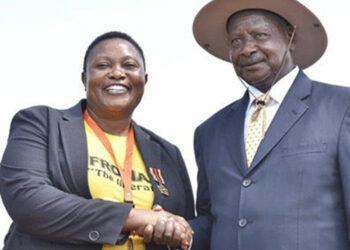The social – economic effects of the conflict is indeed immense. Many lives have been lost, residents were subjected to both physical and mental torture, property worth billions destroyed and the once cordial relationship between the two tribes is completely shattered. The conflict also did not spare the already troubled relationship between Government and the people of Acholi sub region.
It is mainly women and children who bears the brunt of the atrocities. The lives of children living in Apaa is structured around conflict. They are exposed to violence driven lifestyle, their opportunity for unrighteous family upbringing is lost, they are unable to access basic health services and quality education is not anywhere nearby. Consequently, their dreams for a better future is bleak. If these shortcomings are not addressed immediately, it will have a strong bearing on the lives of the future generation of Apaa and the neighborhood.
In view of the above, through simple Questions and Answers, I would like to share with other stakeholders my perspective of the conflict. It is intended to facilitate the process of finding a lasting solution to the conflict.
Q. Is there historical conflict between the two tribes?
A. No! There is no historical conflict between Acholi and Madi. Except, there were occasional clashes between sections of the two tribes in the early eighteen century. This was mainly due to cattle raids, scramble for water & food during draught and other social issues. Whenever such clashes occur, the chiefs and elders from either sides would immediately intervene and ensure that the grievances are addressed and the parties involved reconciled.
The good relationship resulted into intermarriages between the two tribes. One of the intermarriages was between a young man from Atiak in Amuru district and a beautiful lady from Pakele in Adjumani district. The two were blessed with six children and the third born is the author of this article. Actually, I am a living testimony, that there is no bad blood between the two tribes.
Q. Is Apaa in Amuru or Adjumani district?
A. The location of Apaa as of now, is not clear. This is because since the conflict began, there has been no official boundary opening of the two districts, witnessed and acknowledged by all the stakeholders. However, this does not rule out the possibility that Government could have, through other means ascertained the location of Apaa, as stated by the President in Gulu recently.
Whatever the case, there is URGENT needs for the official boundary opening of the two districts. Because, this is the only way through which a fair decision over the dispute can be arrived at. For avoidance of doubt, the exercise should be done transparently with full participation of all the stakeholders.
Q. Is it illegal for Acholi to live in Adjumani district or vice versa.
A. No! It is not illegal. The 1995 Constitution gives Ugandans liberty to settle and live in any part of the country, provided that, it is done within the relevant laws and customs. Atiak Sub county which is a few miles from Apaa is an example to this. Villages in Atiak Sub County dominated by Madi community include:- Lukuliya, Acupele, Murulii, Odutoo, Abalokodi, Bibia and Elegu.
If the two tribes can live together peacefully in Atiak and other places, then what is unique with Apaa, that they cannot coexist? Is there a invisible hand driving a wedge in between the two tribes? Is it a tradition that the land in Apaa shall be occupied by only one tribe at a given time? Or, the land is so precious that one must own it, even if it means taking lives of other people.
Q. Have the people responsible for the atrocities committed in Apaa, brought to justice?
A. No! Most of the perpetuators of crimes committed in Apaa were not brought to justice. This was mainly because, most of the crimes reported were mishandled by Police and the sister security agencies. Some of the crimes were not investigated at all, while others were investigated but not conclusively.
These shortcomings squarely rests on the shoulders of the top leadership of Government agencies responsible for maintaining law and order in the area. It is either, out of institutional weakness, or deliberate acts aimed at frustrating the residents, so that they leave the Apaa. This tantamount to criminal negligence, which is a grave offence in the laws of this country.
Q. Is it true that some Politicians are fueling the conflict instead of quelling it?
A. Yes! Under the guise of sympathizing with the affected people, some politicians have been inciting the two tribes against each other, or against Government. Opposition politicians are also capitalizing on Government’s weaknesses in managing the conflict, to gain popularity.
The participation of Political Leaders, Civil Society Organizations and other stakeholders in supplementing Government’s efforts in managing the conflict, is a good idea. But it has to be done objectively without any ultra motive. It is also advisable that, they should not rush to portion blames before properly analysing the conflict.
If Political Leaders from both tribes, had right from the beginning of the conflict, formed a common front to objectively address issues igniting the conflict, the conflict would have been resolved at the infant stage. But unfortunately, most of them were taken up by petty issues like tribal, religious, and party differences.
Q. Has Government done enough to resolved the conflict in Apaa?
A. No! Government has not done enough to resolve the conflict. All along there has been laxity by the arm of Government responsible for resolving the conflict. For example, even when the Armed Forces were heavily deployed in Apaa to maintain order, but attacks from either sides continued unchecked. The truth is, Government failed to fulfill its obligations to protect the lives and property of residents of Apaa.
The only positive development from Government is, the Commission of inquiry recently appointed to investigate the conflict. This is a step toward the right direction.
Q. Will the Commission of Inquiry bring the conflict to an end?
A. Yes! If the Commission:-
~ does it’s work independently, without being subjected to the direction or control of any person or authority;
~ cast the net wide enough to capture views of all the key stakeholders, particularly: Elders, Cultural leaders and Religious leaders;
~ dig deep into the historical background of the land and the genesis of the conflict;
~ avoid being too bureaucratic and time wasting;
~ make a comprehensive, precise and compelling report, based on evidential facts; and
~ come up with a Work Plan and time frame for the implementation of the recommendations.
Q. What next, if it is ascertained that Apaa is in East Madi Wildlife Reserve?
A. If it is ascertained that Apaa is in East Madi Wild Life Reserve, then there are two options at the discretion of Government, with the approval of the Parliament. The first option is to de-gazette the Wildlife Reserve to allow continuation of the settlement, while the second option is to facilitate the exit of the squatters from the Wild Life Reserve.
The first option may appear cheap and politically friendly, but given the values of conservation in this error of climate change, it will be very costly in future. The second option of facilitating the exit of the squatters from the Game Reserve, is expensive and politically unfriendly. But, given the importance of conservation, it is worth it.
In the event that Government chose to facilitate the exit of the settlers, then fair rate for compensation should be work out, based on the relevant legislations. The methods recently proposed by the Prime Minister, of providing uniform packages without proper assessment should be avoided.
Q. What if it is established that Apaa is in Amuru district, hence outside East Madi Wildlife Reserve?
A. If it is established that Apaa is outside East Madi Wildlife Reserve, then:-
~ All the residents of Apaa, regardless of tribes should be given freedom and protection to continue living in Apaa;
~ They Should also, be assisted by Government to formalise their land ownership;
~ Government should institute a Technical Team to investigate the atrocities committed in Apaa, with the aim of ensuring that the perpetuators are brought to Justice and the victims compensated.
~ Efforts should be made by all the stakeholders to reconcile the two tribes.
Conclusion:-
The world we are living in is a world of change. Whether wishfully or not, there is bound to be changes in our lives. Therefore, in the event that we cannot stop a change, we should learn to live with it. Unfortunately, most people have not appreciated these facts. Consequently, they always find themselves into problems for resisting change.
The writer is a resident of Okidi Village in Atiak Sub County – Amuru District.













